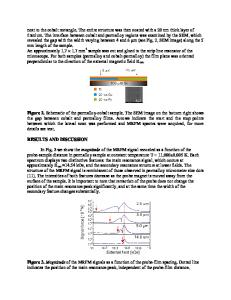Effect of Slow Ion Relaxation at Ferromagnetic Resonance in a CoFeB-LiNbO Metal-Insulator Nanocomposite
- PDF / 528,145 Bytes
- 4 Pages / 612 x 792 pts (letter) Page_size
- 83 Downloads / 252 Views
D MATTER
Effect of Slow Ion Relaxation at Ferromagnetic Resonance in a CoFeB–LiNbO Metal–Insulator Nanocomposite A. B. Drovosekova, *, N. M. Kreinesa, A. S. Barkalovaa, b, S. N. Nikolaevc, A. V. Sitnikovd, and V. V. Rylkovc, e a
Kapitza Institute for Physical Problems, Russian Academy of Sciences, Moscow, 119334 Russia b National Research University, Higher School of Economics, Moscow, 101000 Russia c National Research Center Kurchatov Institute, Moscow, 123182 Russia d Voronezh State Technical University, Voronezh, 394026 Russia e Institute of Radio Engineering and Electronics (Fryazino Branch), Russian Academy of Sciences, Fryazino, Moscow region, 141190 Russia *e-mail: [email protected] Received May 28, 2020; revised June 3, 2020; accepted June 4, 2020
Metal–insulator nanocomposite (CoFeB)x(LiNbO3)1 – x films are studied by the ferromagnetic resonance method in the temperature range of 4–320 K. In the low-temperature region, the maximum of the ferromagnetic resonance linewidth and a negative dynamic shift of the absorption peak, typical of the mechanism of slow ion relaxation on magnetic impurities, are found. The observed magnetic relaxation features can be caused by paramagnetic Co and Fe ions, which are dispersed in the dielectric LiNbO3 matrix and are exchange-coupled to ferromagnetic CoFeB granules. Experimental temperature dependences of the ferromagnetic resonance linewidth and shift are in good agreement with theoretical curves obtained within the proposed approach. DOI: 10.1134/S0021364020140088
Granular metal–insulator nanocomposite of the composition (CoFeB)x(LiNbO3)1 – x is a synthetic multiferroic, attracting great interest because of the potential possibility of nontrivial magnetoelectric effects [1]. Recently, it was shown that this nanocomposite is a promising material for the implementation of resistive memory elements (memristors) that simulate the functions of synapses in neuromorphic networks [2–4]. The studies of magnetic dynamics in metal–insulator nanocomposites are of both fundamental and applied interest. The possibility of combining a high resistivity and a high permeability in granular systems makes them attractive for the use in high-frequency microelectronic devices [5]. On the other hand, such structures are interesting model objects for studying the effect of the parameters of individual particles and interparticle interactions on the dynamic characteristics of the system, in particular, on magnetic relaxation mechanisms. In our previous work [6], mechanisms of resonance peak broadening in (CoFeB)x(LiNbO3)1 – x nanocomposite films were studied by the ferromagnetic resonance method at room temperature when the ferromagnetic phase concentration x changed near the metal–insulator transition xc ≈ 0.43. It was shown that
mechanisms of ferromagnetic resonance line broadening caused by features of the magnetic inhomogeneity of films prevail in the studied range of x = 0.27– 0.48. Moreover, in the region of low concentrations x < xc , the ferromagnetic resonance spectrum can be
Data Loading...











